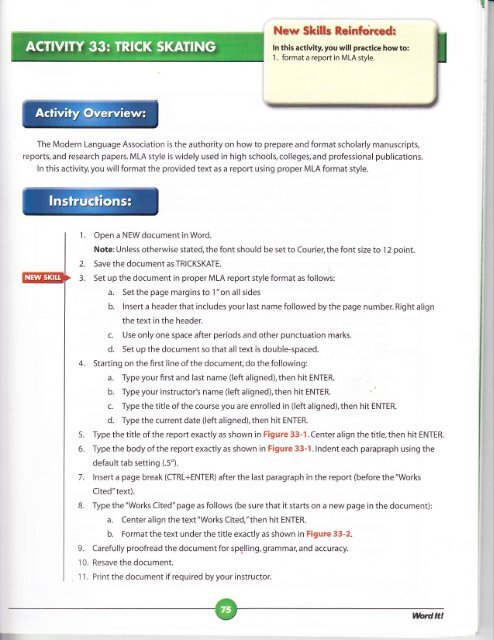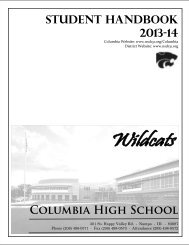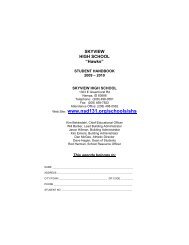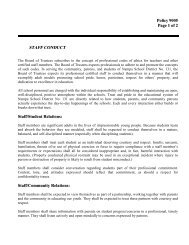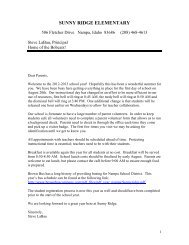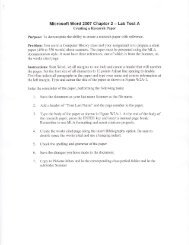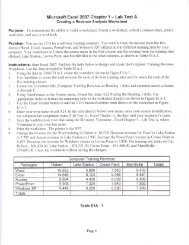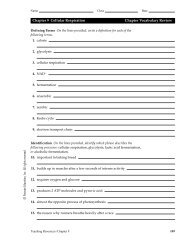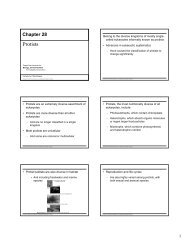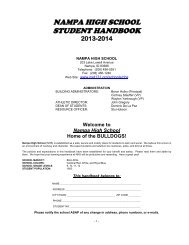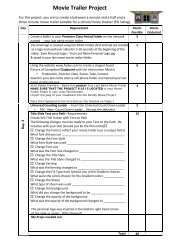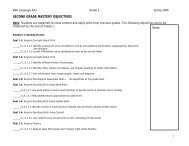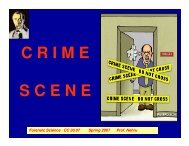Word It Activity 33 Trick Skating.pdf
Word It Activity 33 Trick Skating.pdf
Word It Activity 33 Trick Skating.pdf
- No tags were found...
You also want an ePaper? Increase the reach of your titles
YUMPU automatically turns print PDFs into web optimized ePapers that Google loves.
l-In this activity,you will practice how to:1. format a report in MLA style.The Modern Language Association is the authority on how to prepare and format scholarly manuscripts,reports, and research papers. MLA style is widely used in high schools, colleges, and professional publications.ln this activity,you willformat the provided text as a report using proper MLA format style.1. Open a NEW document in <strong>Word</strong>.Note: Unless otherwise stated, the font should be set to Courier, the font size to 12 point.2. Save the document as TRICKSKATE.3. Set up the document in proper MLA report style format as follows:a. Set the page margins to 1"on all sidesb. lnsert a header that includes your last name followed by the page number. Right alignthe text in the header.c. Use only one space after periods and other punctuation marks.d. Set up the document so that all text is double-spaced.4. Starting on the first line of the document, do the following:a. Type your first and last name (left aligned), then hit ENTER.b. Type your instructor's name (left aligned),then hit ENTERc. Type the title of the course you are enrolled in (left aligned), then hit ENTER.d. Type the current date (left aligned),then hit ENTER.5. Type the title of the report exactly as shown in Figure <strong>33</strong>-1 . Center align the title, then hit ENTER.6. Type the body of the report exactly as shown in Figure <strong>33</strong>-1 . lndent each parapraph using thedefault tab setting (.5").7 . lnsert a page break (CTRL+ENTER) after the last paragraph in the report (before the "WorksCited"text).8. Type the "Works Cited" page as follows (be sure that it starts on a new page in the document):a. Center align the text"Works Cited,"then hit ENTER.b. Format the text under the title exactly as shown in Figure <strong>33</strong>-2.9. Carefully proofread the document for spelling, grammar, and accuracy.10. Resave the document.1 1 . Print the document if required by your instructor.
!\=;Figure <strong>33</strong>-1A Skater Performs a Kickllipwith the evolution of skate parks and ramp riding, theskateboard. began to change. Early skate tricks consisted mainly oftwo-dimensional rnaneuver€t (i.e., riding on only t'he front wheels(nose manual), spinning like an ice skater on the back wheels (a350 Bivot), high jumping over a bar (sometimes called a "Hippieilumpo), long juryring from one board. to anot'her (often over fearlessteenagers lying on ttreir backs)'and slalom.In L975, skateboard.ing was transformed by the invention ofthe first modern skaUeboarding trick by AIan *Ollie" Gelfand. <strong>It</strong>remained. largely a unique Florida trick from 1975 until the sr11pnerof 1-978, when Gelfand made his first visiU to California. Gelfand andhis revolutionary maneuver caught the attention of the west CoaEtskaters and the media where it began to spread worldwide. Arr ollieis performed by popping the tail of the skateboard' slid'ing thefront foot towards the nose and lifting up the back foot to leve<strong>It</strong>he skateboard out. This results in the skateboarden' along withhis or her skateboard, lifting into the air without the aid of footstraps or the skateboarder's hands.The ollie was reinvented by Rodrrey Mullen in 1981' whoadapted it to freestyle skating by ollieing on flat grourid ritherthan out of a vertical ramp. Irfgllen also invented the ol]-ie kickflip, which, at the time of its invention' was dubbed the "nagicflip." The flat ground otlie allowed skateboarders to perform tsricksin mid-air without any more equipment than the skateboard itself.The development of tlrese complex tricks by Rodney lhrllen and otherstransformed skateboarding.Skateboarders began performing their tricks down stair setsand on other urban obstacles - they were no Longer corrfined to emptypools and o
FFigure <strong>33</strong>-1 (continued)the back truck while grinding a rail), the nose grind (balancing ononly the fronu trrrck while grinding a rail), and the \rcrooked grind"(balancing on the front trrrck at an anELe whiLe grinding).L:;*t'FL-L]FFL;tFFigure <strong>33</strong>-2There are various other grinds that invol-ve touching both thetrucks and. the deck to the rai1, ledge, or lip. The most comrnon ofthese is the smith grind, in whish the rider balances over the backtruck while touching ttre outer middle of the board to the grind,ingsurfaqe in the direction from which he or she ollied. Popping andlanding on the back truck and. touching the inner edge of the board,(i.e., popping \over"), is known as a feeble grind. "Board. slides,',"l,ip sJ-ides," "nose slides," and "taiL slides" are other variationsof grinding that are characterized by sliding on an obstacle whilebalancing on the (usually wooden) deck of the skateboard,, ratherthan on the trucks.works CitedHowell, Ocean. NE*treme Market Research." Topic Magazine 13 December2005


